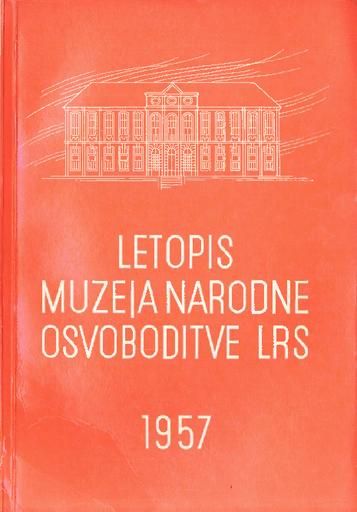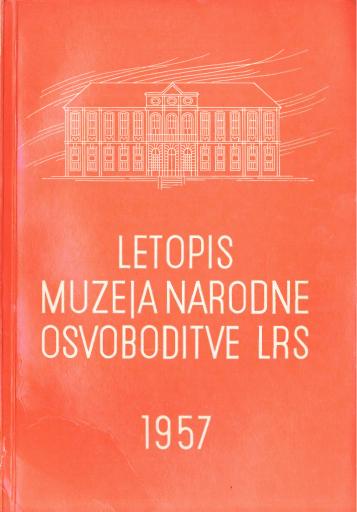/
Serijske publikacije
/
Prispevki za novejšo zgodovino
Ilegalne tiskarne grafičnega oddelka »B« Pokrajinske tehnike KPS za Gorenjsko
(Časovni in številčni bibliografski prikaz izdelkov tiskarn po ohranjenem arhivskem gradivu v Muzeju narodne osvoboditve LRS)

Datoteke (1)

Opis
Ilegalno partizansko tiskarstvo je po padcu ilegalnih tiskarn v Ljubljani doživelo poseben razmah zopet po kapitulaciji Italije na Dolenjskem, ko sta bili preneseni v svobodne slovenske gozdove, tiskarni iz Novega mesta in Kočevja. Tudi Gorenjska je dobila že v decembru 1943 prvo ilegalno tiskarno, imenovano »Tiskarna OK KPS Kamnik« (pozneje imenovana 7-A), ki je začela delati v Šrajevi opekarni v Radomljah, se nato preselila v Rudnik nad Radomljam! in-nato v Kamniško Bistrico. Zaradi težavnejših zvez preko Save in ker se je zadrževalo vodstvo osvobodilnega gibanja za Gorenjsko (Oblastni komite KPS za Gorenjsko — odslej Obl. K KPS za Gor. in Pokrajinski odbor Osvobodilne fronte za Gorenjsko — odslej POOF za Gor.) na ozemlju, ugodnejšem za osvobodilno gibanje, t. j . na desnem bregu Save v območju Poljanske in Selške doline in ker je bila tu tudi »Pokrajinska tehnika KPS za Gorenjsko« (odslej PT KPS za Gor.), ki je organizacijsko povezala in vodila vse partizansko tiskarstvo na Gorenjskem, so začeli misliti na to, da bi postavili tudi na tem področju ilegalno tiskarno, saj ciklostilne tehnike, čeprav številne, niso mogle zadostiti z narodnoosvobodilnim tiskom vseh potreb Gorenjske.
Metapodatki (11)
- identifikatorhttps://hdl.handle.net/11686/4609
- naslov
- Ilegalne tiskarne grafičnega oddelka »B« Pokrajinske tehnike KPS za Gorenjsko
- (Časovni in številčni bibliografski prikaz izdelkov tiskarn po ohranjenem arhivskem gradivu v Muzeju narodne osvoboditve LRS)
- Illegal printing press of the Provincial technic of the Communist Party of Slovenia for Gorenjsko
- ustvarjalec
- Jože Krall
- soavtor
- Milan Bevc (odg. ur.)
- predmet
- druga svetovna vojna
- NOB
- partizanske tiskarne
- partizanski tisk
- Second world war
- National liberation war
- Partisan printing press
- opis
- The partisan illegal press got a new push after the collapse of illegal printing works in Ljubljana after the capitulation of Italy when from the liberated towns of the then Province of Ljubljana printing machines with the necessary outfit and material were taken to the free woods of Slovenia. This decision was important because after the German offensive in the autumn 1943 these towns were occupied by Germans who made these towns their stable strongholds. In the upper parts of Slovenia (Gorenjsko) where the German foe particularly oppressed our Slovene population the leadership of the liberation movement felt a peculiar necessity to encourage by printed word the resistance of the people against the occupier, and to found therefore his own illegal printing press. The organisation of this illegal press was entrusted by the Provincial Committee of the CPS and the Provincial Committee of the Front of Liberation for Gorenjsko to the experienced and skilled partisan technician Edo Bregar-Don, who succeeded in short time to organise in the free woods of the Poljana and Selce valleys three illegal printing works, which depended directly from the graphic department »B« of the Provincial technic CPS for Gorenjska which linked the whole organisation and managed all the illegal presses and technics in Gorenjska. The first printing press, which got the secret name »JULIJA« he put up in the Poljana valley near the village Log where he dug out for it an underground strongpoint, where he placed a small printing machine. In this foxhole the work started on the 26th of March 1944, and a whole series of leaflets, newspapers and booklets were printed. Because of lack of conspiration they were however compelled to transfer the printing offices to a new underground hiding place which was constructed in the neighbourhood of village Brode down the river Sora. But less than a month of work in this place it has been discovered and destroyed by the enemy. The printers could be saved in the attack but the printing machine has gone lost together with all the records of the press, particularly the most beautiful and most copious work of the printing office the poems of the Slovene revolutionary poet Vladimir Pavšič-Matej Bor. In this, printing place there were printed during the whole time of its existence that is since March 26th until August 23rd 1944 30 different prints in a total edition of 150.850 pieces, what makes more than 600.000 copies. The second illegal printing works, named »TRILOF« the machine of which has been projected and partly constructed by the technician Edo Bregar-Don himself, he established in an underground concrete trench in the Ločnica valley near Medvode. On this machine, which allowed prints of bigger quarter size was printed on the 5-VII-1944 as its first produce »Delavska enotnost« (Unity of workers) a paper of the working class. But already after 2 months of work the printing machine was transferred to Davča in Selce valley. The party carrying parts of machine and the printing material was attacked by Germans when crossing the Sora and the road in Poljana valley where eight partisans fell. At this, occasion several parts of machine and some letters were lost. On the new place at Davča high under the Blegoš Mountain they erected in a wild difficult accessible ravine a wooden hut, where they brought the remaining parts of the machine. The printing machine was repaired, new letters were supplied, and the work continued, until the 2nd of November, when an earth avalanche torn because of a long heavy rain from the steep slope crushed down the hut and burried the machine together with other material. But this disaster too did not take the courage to the persisting partisan printers. They dug out the machine' and letters, and started to print again at a new hidden place. On this spot in the wildness of the woods of Davča under the peasant Span was printed the loveliest and technically most exiting copy, the bibliophile edition of Prešeren's »Zdravljica« (Toast) in 1500 numerated copies. This edition made out in three-coloured print (black, red and gold) is richly illustrated by wholepage artistic linotypes of the painter partisan Janez Vidic and vignettes of the architect Marjan Sorli-Viher. On the front page it has remarkable time fitting dedication, reading: »Issued at the centenary of the »Toast« in the days, when the Slovene people in the holy patriotic war by the blood of his best sons is fulfilling the will of his great singer and seer.« Once more the printers in the plant Trilof had to cease with their work for a longer period. Almost at the end of the war in the middle of March 1945 the German occupator started his great offensive against the National Liberation Army just at the place where the printing machine lay hidden. The printers had again to change the printing tools for rifles to leave their works and to fight through enemy traps and ambushes. But the enemy did not discover in his onslaught the very well hidden, printing plant. The printers returned in the middle of April and started to print again various leaflets, proclamations and booklets, which were mostly printed in two or three coloured print, and embellished with illustrations.' They worked in the printing plant until the liberation, and their last sheet was printed in the night from the 9tl1 to 10t h May 1945. The printers who worked on account of various shiftings of the print plants and German offensives only 8 months on the place printed on an primitive printing machine, which they had to move by hands, 102 different prints in a total edition of 447.214 copies, what makes according to printed copy pages 943.904 stamps.'
- The partisan illegal press got a new push after the collapse of illegal printing works in Ljubljana after the capitulation of Italy when from the liberated towns of the then Province of Ljubljana printing machines with the necessary outfit and material were taken to the free woods of Slovenia. This decision was important because after the German offensive in the autumn 1943 these towns were occupied by Germans who made these towns their stable strongholds. In the upper parts of Slovenia (Gorenjsko) where the German foe particularly oppressed our Slovene population the leadership of the liberation movement felt a peculiar necessity to encourage by printed word the resistance of the people against the occupier, and to found therefore his own illegal printing press. The organisation of this illegal press was entrusted by the Provincial Committee of the CPS and the Provincial Committee of the Front of Liberation for Gorenjsko to the experienced and skilled partisan technician Edo Bregar-Don, who succeeded in short time to organise in the free woods of the Poljana and Selce valleys three illegal printing works, which depended directly from the graphic department »B« of the Provincial technic CPS for Gorenjska which linked the whole organisation and managed all the illegal presses and technics in Gorenjska. The first printing press, which got the secret name »JULIJA« he put up in the Poljana valley near the village Log where he dug out for it an underground strongpoint, where he placed a small printing machine. In this foxhole the work started on the 26th of March 1944, and a whole series of leaflets, newspapers and booklets were printed. Because of lack of conspiration they were however compelled to transfer the printing offices to a new underground hiding place which was constructed in the neighbourhood of village Brode down the river Sora. But less than a month of work in this place it has been discovered and destroyed by the enemy. The printers could be saved in the attack but the printing machine has gone lost together with all the records of the press, particularly the most beautiful and most copious work of the printing office the poems of the Slovene revolutionary poet Vladimir Pavšič-Matej Bor. In this, printing place there were printed during the whole time of its existence that is since March 26th until August 23rd 1944 30 different prints in a total edition of 150.850 pieces, what makes more than 600.000 copies. The second illegal printing works, named »TRILOF« the machine of which has been projected and partly constructed by the technician Edo Bregar-Don himself, he established in an underground concrete trench in the Ločnica valley near Medvode.
- založnik
- Muzej narodne osvoboditve LRS
- datum
- 1957
- tip
- besedilo
- jezik
- Slovenščina
- jeDelOd
